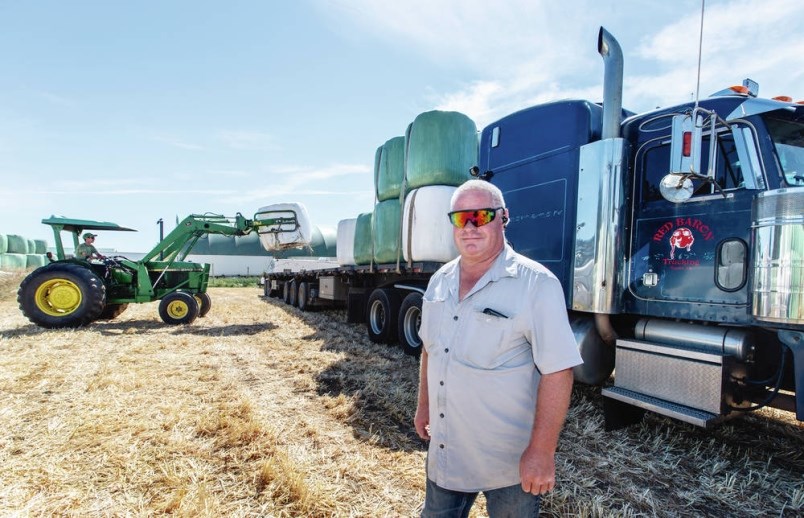Central Saanich farmer Bryce Rashleigh has plenty of what Matt Kitchen, a rancher in the Kootenays, so desperately needs.
Hay. And lots of it.
There are more than 3,000 big bales, wrapped and ready, that have been languishing on Rashleigh’s farm since spring as the pandemic slammed his biggest customer, the horse-carriage industry, and reduced demand from Island dairy and beef producers.
But now, with drought and wildfires ravaging the cattle industry in the Interior, ranchers are reaching out as their feed dwindles.
“Lots of our neighbours are destocking,” Kitchen said in an interview from his ranch near Beaverdell.
“For a lot of the 200-cow guys … the hay crop is about 40% of normal. They’re in the same boat, either selling some, or everything off, or looking for hay.”
Kitchen said his markets in a normal year are from Washington or Alberta, but those hay regions also have shortages because of drought.
Rashleigh shipped two semi-truck liner loads last Friday — one to a dairy in Armstrong and the other to rancher northeast of Kamloops — and loaded another two on Wednesday — for Kitchen’s Grassland Grazers Ranch and a farm near Kelowna.
Every load carries 60 big round bales with each bale weighing about 950 pounds. Rashleigh’s product is called haylage, as it is baled with a high moisture content and nutrient rich for livestock.
Rashleigh said he isn’t profiting from the sales. He’s selling the bales for $50 each — the cost to produce them. Shipping ranges from $33 a bale to Kamloops and more than $40 to Kelowna. The further east, the higher the shipping cost.
For Kitchen, the cost is higher than a dry bale he would normally buy, but, under the circumstances, the extra cost is worth keeping his operation afloat.
He has already had to sell off a herd of contract yearling cattle in July, as opposed to the fall, just to preserve the precious grass and hay he has left for about 60 ewes and lambs and a herd of 50 cows.
Farmers across the west face a perfect storm amid a prolonged drought that has depleted water sources and hay crops, and sent grain prices higher as yields whither in the heat and pests such as grasshoppers proliferate. Wildfires are destroying grazing lands forcing the relocation of some herds. Some ranchers are selling out just to recover costs.
Selling off cows means ranchers won’t have any means to produce calves next year or in the future.
On Tuesday, provincial and federal governments announced $100 million in funding to support producers with relocation and feed costs.
In a statement, B.C. Agriculture Minister Lana Popham said the losses “have been heartbreaking and recovering them will take time, commitment and support.”
Rashleigh is elated that his hay — which might otherwise spoil where it lies — is going to where it’s needed.
“We’ve got young families who are just trying to get enough feed to have their cattle survive the winter … it’s their livelihoods,” Rashleigh said from his farm, where he grows barley and wheat, and raises poultry.
He has been touched by the generosity of his local customers, who are sponsoring bales with donations to offset the transportation costs to Interior ranchers and farmers.
“We had one customer who came for eggs the other day and she asked where the bales were going,” said Rashleigh.
“She came back an hour later with an envelope. It had $400 in it and said it was for the cows [in the Interior]. All of the money is going towards the freight.”
Rashleigh said calls are coming in from all over the West, including several farmers in Alberta and as far east as Swift Current, Sask.
Kitchen, 30, who works a farm with his wife, Erin, and two young children, market their meat directly to buyers in the Okanagan. They own 160 acres and lease another 600 acres, most of it forested with grazing patches.
“We have land payments and expenses. We don’t make our own hay or have the equipment, so we have to buy the hay that’s needed. Right now, that isn’t easy,” Kitchen said, adding they could use between 500 and 600 large bales to get through to next year.
“We don’t have any fires yet, but the drought conditions all around us have drastically reduced [the supply]. Everybody’s looking.”



